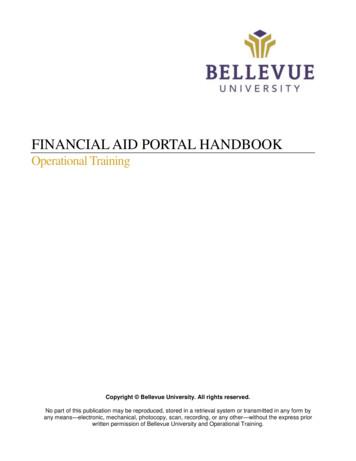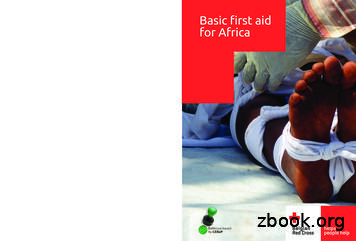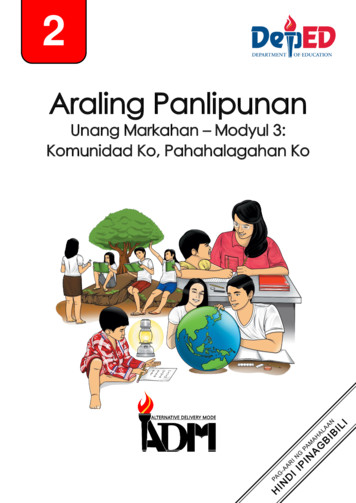SECTIONII 2020 FIRST AID RULES
SECTION II2020FIRST AIDRULES
2020 FIRST AID CONTEST RULESINDEXTitleSection IIPageRules Governing the 2020 First Aid Contest.1Scorecard A Discounts .10Interpretations of Scorecard B (Artificial Ventilation/CardiopulmonaryResuscitation). .14Skill SheetsInitial Assessment .18Patient Assessment .19One-Person CPR (Manikin Only) .21Two-Rescuer CPR (Manikin Only).23Mouth-to-Mask Resuscitation .29Airway Obstruction .30Sucking Chest Wound.32Life Threatening Bleeding.33Tourniquet.34Dressings and Bandaging – Open Wounds .35Two-Person Log Roll .37Three-Person Log Roll . 38Splinting . 39One Rescuer Blanket Drag.47Ground Lifts.48Shirt Drag . 49Establishing Airway – Suspected Cervical Spine (Neck) Injury .50Shock. 51Immobilization .52Burns . 54Frostbite. 56Late or Deep Cold Injury .57Hyperthermia .58First Aid Statements of Fact.601
RULES GOVERNING THE 2020 NATIONAL FIRST AID CONTESTFirst Aid rules were designed as a training tool for first aid teams. They weredeveloped for contest purposes only. Discretion should be used in actual mineemergency situations.1.All First-Aid Problems will be sent to either the Chief/Assistant Chief Judge ofFirst-Aid for review and approval.2.Members of First Aid Teams must be composed of persons who are bona fideemployees of the mining companies or persons who are designated or contractedby mining companies. Teams shall furnish their own recording manikin,(provided with the equipment to print out the results of CPR/AV) and all othermaterials listed in section C. Miscellaneous below.3.A team shall consist of two members and a patient. A team shall not use the samepatient for multiple teams. Bystander(s) may only assist in supporting, lifting, ormoving the patient. If the problem requires a bystander(s), they will be provided.Bystander(s) will be positioned at the field and will be identified as a bystanderwith labels or name tags and Body Substance Isolation (BSI) precautions will be inplace. If a patient is used as a bystander, teams must provide BSI precautions priorto patient contact. Each team shall work one first aid problem and the score shalldetermine the team’s final standings.4.Each team entering the contest will draw a number to determine the order of theperformance at the time of registration.5.Each participating team must be under guard before the start of the contest. Anyteam or team member receiving information concerning a contest problem prior toarriving at the working area will be disqualified by the Chief Judge and Director.6.No practicing will be allowed on the field before the beginning of the contest. Noreference books or training material will be permitted in the working area duringthe working or reading of the problems.7.Only designated officials will be allowed to communicate with teams while teamsare working.8.All procedures shall be performed in the order listed: Skill Sheets supersede FirstAid Rules which supersede Brady First Responder Tenth Edition by Bergeron andLe Baudour.2
9.Contest officials will designate a space (15 feet by 15 feet minimum) for teams towork. All equipment and team members will be kept behind a baseline designatedby a contest official. All problems will be worked in the designated area whichshall contain only the judges, bystanders/patients and the contesting teams.Team members not complying with this rule will be docked under Rule 18 onScorecard A10.The timekeepers shall explain to the team the timing devices used. Prior tostarting the timing devices Judges will require a sample CPR tape with a signatureand team number on the sample CPR tape. (Check shallow breaths and shallowcompressions).11.Problems will be kept in unsealed envelopes, retained by the judges, and given tothe team after the timing device has been started. Judges shall place the patient inthe required position as stated in the problem to be worked.a. The working time for a problem will start when the team starts the timingdevice.b. If props are to be utilized during the working of the problem, such props mustbe readily available to the working teams and in working condition. Props(except props used to simulate an injury) must be identified by the judges tothe team members prior to starting the timing device and must be locatedwithin the designated working area. Props will not be utilized in lieu of firstaid equipment for treatment of patient(s). Props will be limited to items relatedto communication and mechanism of injury for effects unless skill sheets areprovided. Props shall be within the application of the skill sheets used fortreatment of the injury/conditions.c. A barrier device must be used when contacting manikin. The facemasks/shields may be removed when the team is required to give artificialventilation, CPR, inflating splints, etc.12.Injuries/conditions requiring treatment will be identified by cards, envelopes orlabels attached to the patient at or as near the location of the injury as possible onthe outside of the clothing, be identified by simulated wounds, or be in the readingof the problem. Signs, symptoms or mechanisms of injury may be used. If signsand symptoms are used, all signs and symptoms shall be identified by cards,envelopes or labels placed on patient. All signs and symptoms will be given to theteams in writing. Wounds that are listed in the reading of the problem shall alsobe placed on patient. (Exception: If the wound is on the eyelid or an impaled3
object in the eye, the label will NOT be placed on the eye, but in an obvious areanear the eye.)During the initial or patient assessment, teams may find an envelope attached tothe patient(s) or be provided an envelope by the judges which contains patientinformation that needs immediate attention. If repositioning of patient(s) isrequired for treatment, patient(s) must be placed in the proper position prior totreatment. Upon completion of treatment of these conditions, the initial or patientassessment will be resumed at the point where team left off. The patient(s) willalready be marked upon arrival of the team.13.Lettering on the cards and/or labels will be at least 1/4-inch in height and all lifethreatening conditions will be in red.Example: 2-INCH WOUND ON FOREHEAD14.The problem will end and teams will stop the timing device when all conditionshave been located, treated, and the work area has been cleaned. Thetimekeeper/judge must time the problem in minutes and seconds and consultwith the team upon completion of the problem to verify the time.15.After stopping the timing device, team members will remain with the patient(s)until released by the judges. Any physical treatment(s) not performed, i.e.bandage, splint not correctly placed or utilized will be pointed out to team at thistime.16.The calculated time will be determined by contest officials by averaging theworking time of all teams participating in the contest (1 discount per 3 minuteovertime or fraction thereof). When a time limit is utilized the average workingtime will not be in problems.17.The accumulation of individual discounts within a procedure shall not exceed thediscounts for failure to perform that procedure. (Example AV, CPR, etc.)4
A. Written Examination1.During isolation, contest officials will give the written exam to the two workingteam members. The written examination will be ten statements of fact takenverbatim from the contest rules. Each statement shall contain a blank space whichshall represent a key word, with no more than two consecutive blanks perstatement. Answers will be multiple choice with three choices. Answers will not beintentionally misspelled. “None of the above” shall not be used as one of thechoices.A maximum of fifteen minutes will be allowed for the team members to take thetest.2.Team members taking the written examination will not be permitted to take anywritten material or information into the testing area.3.There will be no discussion during the time that written examinations are beingtaken.B. TiesIn the event of ties in the contest, Scorecard A (First Aid Procedures and Critical Skills)discounts will be the first tie breaker, Scorecard B (AV/CPR) discounts will be thesecond tie breaker, written exam will be the third tie breaker and actual working time,in minutes and seconds, of the team will be the fourth tie breaker.C. MiscellaneousTeams will be notified by posting when they may review their score cards. Within onehour of posting, team members and trainer shall report to a designated location. Oncenotified, team members and the trainer shall have 20 minutes for reviewing theproblem, the judge’s skill sheets and scorecards to prepare any protest. All protestsshall be in writing and shall state the discount in question, the scorecard involved, andtheir reference proof in the rule book or Brady book to support their protest or theprotest will not be considered. All protests will be considered by the Final AppealsCommittee. A decision by the Final Appeals Committee is binding and final. Protestsheets will be furnished to the teams by the judges for the recording of rules infractionsor discounts assessed to teams. Judges shall remain available until released.5
MATERIALS LISTParticipants will be required to furnish their own materials. Teams must provide theminimum equipment. Listed below is the minimum equipment required. Problemswill be designed utilizing no more than the minimum material list. For contestpurposes, all bandaging materials will be considered sterile. For contests purposes onlyfour by four dressings need not be opened before use for treatment.2462463162Triangular BandagesAdhesive compressesSterile gauze, (4”x4”) and/or 4” CompressesRoller BandagesBlanketsScissors, EMT UtilityPairs of Examination GlovesMask/face shields or masks and goggles combination meeting blood bornepathogen requirements2 Heat Pack - Simulated4 Cold packs - Simulated2 Oval Eye Pads1 Pen and paper set1 Recording manikin (with device to the print results of AV/CPR performed)2 Barrier devices with one-way valve for performing AV/CPR1 White bag (i.e. plastic garbage bag)1 Compliment of splints (may be pre-padded but not assembled)1 Long back board with straps (Aluminum, Wood, etc.)2 Air splints (1 full arm and 1 full leg)1 Adhesive Tape1 Burn Sheet, Sterile (40” x 80” minimum)1 Rigid Extrication Collar4 Trauma Dressings (minimum of 10” X 30”)1 Eye Shield/Cup1 Pen Light4 Tourniquets2 Towels1 Pillow4 Occlusive Dressing2 Sticks, Wooden Dowels or equivalent1 Watch/Timing Device1 Headset (long spine board)1 500 ml sterile water (for contest purposes expiration date not applicable)Compliment of Straps for Long Spine Board (buckle straps, spider straps, etc.)6
Automated External Defibrillator Training Unit (do not power up)Problem will be designed from the Skill Sheets approved by the Rules Committee.Teams will be required to triage the accident scene. Problem may have up to threepatients at the scene.Manikins will be furnished by teams for performing procedures and critical skillspertaining to all ventilation problems, cardiac arrest problems. Signal boxes onmanikins will be covered or positioned so that indicators will not be visible to the team.(Equipment will not be shared) NOTE: Live patients will not be used in any CPR orventilation problems.Under no circumstances will videotape recordings or photos be introduced assupplementary material for consideration of the appeal.Guidelines for skills sheet discounts:1.The team is required to call for help/call 911, once during the working of theproblem. This statement must be made prior to starting triage.2.Each critical skill identified with an asterisk (*) shall be clearly verbalized by theteam as it is being conducted.3.After initially stating what DOTS stands for; Deformities, Open Wounds,Tenderness, and Swelling, the team may simple state “DOTS” when making theirchecks.4.After initially stating what CSM stands for; Circulation, Sensation and MotorFunction, the team may simple state “CSM” when making their checks.5.After initially stating what AVPU stands for; Alert, Verbal, Painful, Unresponsive,the team may simply state “AVPU” when making their checks.6.If an injury requires a back board, the team may continue to the next area to betreated once all injuries not requiring the backboard have been treated ortreatment started.7.The collar for a skull fracture and/or brain injuries, will be applied after the neckhas been examined and treatment completed if required.8.Except for slings required for treatment for fractures or dislocation, slings may beapplied anytime during the working of the problem prior to stopping clock. (This7
includes slings for fractured ribs). Factory or Triangular slings may be used. Nosling required when using a full arm splint, arm should be secured to the body.9.For injuries requiring splinting, any acceptable splint may be used. Factory splints,wooden splints, air splints, sam splints, etc.10. Prior to stopping the clock, the team must reassess the patient’s level ofconsciousness, respiratory status and patient response.11. Teams must make statement to judge, “Removing clothing; exposing and cleaningwound surface(s)”. This statement is only required to be made once during theworking of the problem, prior to treating first wound.12. Rapid Assessment consists of Initial Assessment and Patient Assessment.13. If the Rapid Assessment has been performed, all life threatening injuries are treated,and transportation is delayed the detailed patient assessment will be performedand will consist only of the procedures (no critical skills on patient assessment)with treating all injuries when found.Information for this table taken from Chart figure 27.5– Start Triage SystemIMMEDIATEDELAYEDMINORDECEASEDRespirations 30 per minute 30 per minute 30 per minuteAbsentPerfusionCapillary refill 2 seconds orradial pulseabsentCapillary refill 2 seconds orradial pulsepresentCapillary refill 2 seconds orradial pulsepresentAbsentMental StatusUnable tofollowcommandsAble to followcommandsAble to followcommands(Can Walk)AbsentTable Reference: Emergency Medical Responder, Tenth edition by Le Baudour andBergeronImmediateTeams will systematically conduct initial assessment, treating all life-threateninginjuries/conditions. When one or more of the conditions listed in rule 26 is8
encountered the team will perform a rapid patient assessment according to thepatient assessment skill sheet. To perform a rapid patient assessment, teams willexamine each area of the body in its entirety, verbalizing critical skills andinjuries/conditions found. No treatment is required for non-life-threateningconditions/injuries found during the rapid patient assessment.After completing rapid assessment and treating life threatening conditions, iftransportation is delayed patient treatment will continue until transportation isavailable. A detailed patient assessment would be required, treatingconditions/injuries as found. Straps may be released as necessary. Support wouldhave to be taken as required. Team will re-strap and transport whentransportation is available or treatment completed. Patient is then prepared fortransport and/or transported as required by written problem. To prepare fortransportation, a team will be required to properly place and secure a patient on abackboard as outlined in the skill sheets, cover with a blanket and lift patient fromthe floor. After the patient has been lifted from the floor, the team will verbalize –“transporting patient”. (If instructions are given that transportation is delayedprior to or during a rapid assessment a complete detailed patient assessment onlywill be required)DelayedTeams will systematically conduct the patient assessment according to proceduresof the patient assessment skill sheet. Each area of the body shall be examined in itsentirety prior to treating injuries in that area (except taking support). All injuriesmust be treated on the area being examined prior to moving to the next area to beexamined. The sling for fractured ribs may be applied after upper extremity hasbeen surveyed/treated. If treatment has been started and can be completed byone team member (except injuries requiring a backboard), the other team membermay continue the examination to the next area and begin treatment. (Systemically,legs are treated before the arms.)MinorTeams will systematically conduct the patient assessment according to proceduresof the patient assessment skill sheet. Each area of the body shall be examined in itsentirety prior to treating injuries in that area (except taking support). All injuriesmust be treated on the area being examined prior to moving to the next area to beexamined. The sling for fractured ribs may be applied after upper extremity hasbeen surveyed/treated. If treatment has been started and can be completed byone team member (except injuries requiring a backboard), the other team member9
may continue the examination to the next area and begin treatment. (Systemically,legs are treated before the arms.)DECEASED: Once the determination that a patient is deceased the team will berequired to cover the patient before stopping the timing device(s).SCORECARD A DISCOUNTS1.Violations of general rul
First Aid rules were designed as a training tool for first aid teams. They were developed for contest purposes only. Discretion should be used in actual mine emergency situations. 1. All First-Aid Problems will be sent to either the Chief/Assistant Chief Judge of First-Aid for review and approval. 2. Members
Foreign aid has various different forms; economic aid, social aid and "other aid" components are the main ones. Economic aid is a form of physical capital, aid to both infrastructure and the production stage, social aid refers to aid in form of human capital whereas other aid components entail food and emergency aid (Akramova 2012, 119-120).
ASMEBPVC.II.A-2017 ASME Boiler and Pressure Vessel Code, SectionII: Materials, Part A, Ferrous Material Specifications ASMEBPVC.II.C-2017 ASME Boiler and Pressure Vessel Code, SectionII: Materials, PartC, Specifications for Welding Rods, Electrodes, and Filler Metals ASME BPVC.II.D-2017 ASME
Rules database is the basis of the rules engine and it is a collection of rules files which are established by rules engine. Rules database is maintained by rules management and it is used by rules engine. (5) Rules Matching The first step is modelling with rules files in rules database. Then, it will match rules with users'
Operational Training Financial Aid Step Action 1. Click on the FINANCIAL AID option from the menu or click on the REVIEW & ACCEPT FINANCIAL AID hyperlink in the Financial Aid box. Step Action In the GIFT AID section, you will see aid that cannot be modified by a student. Gift Aid includes: Scholarships, Tuition Assistance, Grants, etc.
curriculum developers First Aid trainers Laypeople performing & receiving first aid What is Cochrane First Aid? Thematic Field of Cochrane Mission: Forming a global network of people advocating for the development, dissemination and uptake of high-quality evidence on first aid Promoting the use of evidence on first aid
Basic first aid . for X. Basic first aid for Africa 'Basic first aid' seeks to equip the lay person with . the basic skills needed to effectively provide first aid, both in cases of minor injuries or illnesses or in the case of emergency situations, until professional medical assistance can be provided. How to treat a burn, or a sprained ankle.
Psychological First Aid (PFA). Ask the group the following questions to set up the introduction to PFA. Facilitator to the group: Psychological First Aid is like medical first aid, only it is for the psychosocial aspects of a person. Thinking about first aid for the physical body, what do you think psychological first aid is for a person?
Araling Panlipunan – Ikalawang Baitang Alternative Delivery Mode Unang Markahan – Modyul 3: Komunidad Ko, Pahahalagahan Ko Unang Edisyon, 2020 Isinasaad sa Batas Republika 8293, Seksiyon 176 na: Hindi maaaring magkaroon ng karapatang-sipi sa anomang akda ang Pamahalaan ng Pilipinas. Gayonpaman, kailangan muna ang pahintulot ng ahensiya o tanggapan ng pamahalaan na naghanda ng akda kung ito .


















